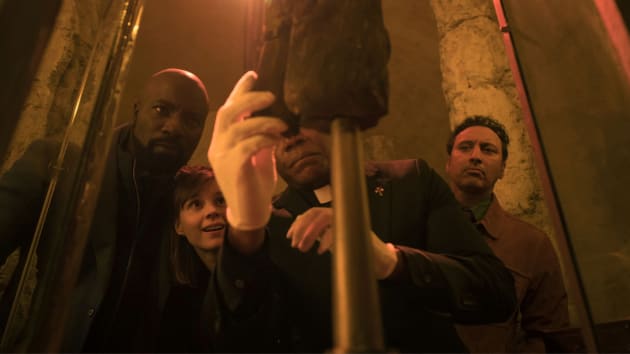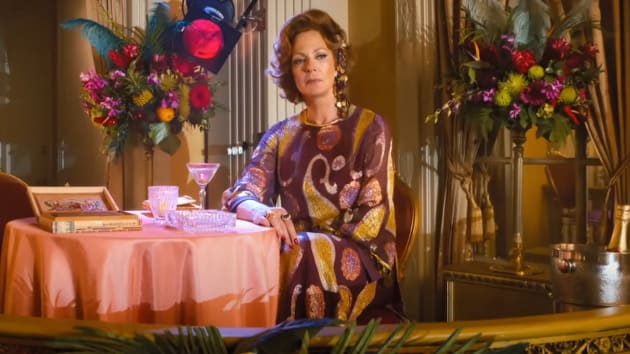The Witcher has a complex mythology filled with prophecies, monsters, mages, and mutant mercenaries. All of these fantastical elements mean that in the world of The Continent, nothing is outside the realms of possibility — a truth which also applies to fan theories about what comes next in Season 2.
In that spirit, earlier this year we presented showrunner Lauren Schmidt Hissrich with six of the craziest Witcher fan theories we could find and asked her to weigh in and share her thoughts on their viability and the reasonings behind them. So do any of them hold water? And which theory is based purely in a production mistake? Read on to find out this and more!
Ciri (Freya Allan) is actually Geralt’s (Henry Cavill) mother. “Wow. Nope, that just blows my mind. I can’t even wrap my head around that one,” Hissrich said in response to this brain-bending fan theory. “I mean, it’s funny because as you step back and you’re like, ‘Well, she would be capable…’ But then that just — it literally makes my mind explode.”
The Witcher’s Lauren Schmidt Hissrich on Writing a Hero Whose Biggest Villain Is the Plot
And while time is a huge theme of The Witcher franchise, Hissrich shared that after she worked on The Umbrella Academy‘s first season she told herself, “I will never again work on a show with time travel because it makes you want to put your head through a wall.” So before you waste your energy trying to figure out what timey-wimey somersaults the series would have to pull off in order to explain how Ciri could one day give birth to Geralt, her adoptive father, you can rest assured knowing that this is one theory we can debunk right now.
 Freya Allan, The Witcher
Freya Allan, The Witcher
Yennefer (Anya Chalotra) used to be a witcher. Despite the fact that The Witcher‘s first season documented large portions of Yennefer’s life from her adolescence through the Battle of Sodden, some fans think there’s still a big part of the sorceress’ past we have yet to see: her time as a witcher.
“How would that work?” a confused Hissrich wondered. And it’s a good question since not only would it be difficult to work in an entire period of her life as a witcher into the timeline we already know, but there’s the added complication of witchers historically being an all-male order — at least until Ciri starts to be trained as one in Season 2. “It’s hard because, of course, once you have the books in your head and so much of witcher lore is about ‘women can’t be witchers’ and how does Ciri start to factor into that? So yeah, that one’s hard for me to wrap my head around,” Hissrich said.
7 Things We Already Know About The Witcher Season 2
Cahir (Eamon Farren) was replaced by the Doppler after their fight. In Episode 6, Cahir tussled with a shapeshifter, otherwise known as a doppler. A popular theory suggests that after this fight, the Cahir we see in the show isn’t actually the Nilfgaardian soldier but the doppler who stole his identity. “Ooh, that’s interesting. I want to keep that one in my back pocket for a while,” Hissrich teased.
“It is a fun idea. It is,” she continued. “That’s one of those scenes that in the editing room, we were like, how are we going to tell the difference between the doppler and Cahir? And at the end, you really don’t care. You know, like they’re fighting, they’re just two men scrapping. Because we had, like, put a cut on one’s cheek or one always has this. But the idea is, when one of them races out, you want to hang in and go like, ‘I don’t know which one just ran away.’ So I like that one.”
 Eamon Farren, The Witcher
Eamon Farren, The Witcher
Ciri’s prophecy predicted climate change. When Ciri’s powers overwhelmed her in Episode 7, she shared the following cryptic prophecy: “Verily, I say unto you the era of the sword and the ax is nigh, the era of the Wolf’s Blizzard. The Time of the White Chill and the White Light is nigh, the Time of Madness and the Time of Contempt.”
These references to blizzards and chills led some to suspect that one of the dangers Ciri’s predicting is global warming. “So I read this one too,” Hissrich said. “And I mean, like all fantasy … you can see it as an analogy for anything that’s happening in our world right now. The best fantasy … is kind of like horoscopes; you should be able to read them and apply them to yourself.”
Hissrich continued, saying that they didn’t necessarily talk about climate change in the writers’ room while crafting the first season, but that it wouldn’t be out of the question for Witcher author Andrzej Sapkowski to have infused the source material with his own beliefs and concerns. “I think a lot of him is in these books, obviously, and a lot of his politics,” Hissrich said. “It’s so funny to me when people talk about not inserting politics into The Witcher. It’s like The Witcher is the most political series that I’ve ever read. I don’t agree with all of it, but I do agree with some of it. And I think Sapkowski probably has a lot more of his beliefs in there than we realized too.”
Netflix’s The Witcher Season 2: Cast, Release Date, and More
Jaskier (Joey Batey) isn’t human and that’s why he doesn’t seem to age. The first season of The Witcher covered an expansive amount of time, but since Geralt is a witcher and Yennefer a sorceress, their powers explain why they never showed the years passing by. Jaskier, however, also didn’t age throughout the first season, so could that mean he’s also more than human?
“No, that was just a mistake,” Hissrich said with a laugh. “We have this enormous timeline in our writers’ room that takes up, like, two whiteboards and it’s how we laid out the stories from Season 1, sort of tracking to make sure that everyone fits in. Jaskier was always the outlier because Jaskier would have aged a lot in that season. No, he just had great genes, you know, clearly,” she quipped.
 Joey Batey, The Witcher
Joey Batey, The Witcher
Ciri will use her powers to fuel Aretuza so they will no longer need to turn girls into eels. The first season revealed that an unfortunate selection of Aretuza students each year are sacrificed for the school, with Tissaia (MyAnna Buring) turning them into eels. This reveal, which wasn’t in the books, was divisive among fans, which might explain this theory, per Hissrich. “You know, that theory comes from people who hate the eels. ‘Let us never see the eels again!'” Hissrich said before noting she’s personally a fan of them.
“That came from the brain of Jenny Klein, one of the writers,” Hissrich said of the eels’ origin. “You know, I have two kids. They’re huge fans of Harry Potter. So I have read, seen, done everything about magic schooling. And it was like, what’s different about Aretuza? How do we not make it just become this beautiful place where you go and you get powers and you get anything you want, because that takes conflict out of it. So it was fun to sort of watch all of these young women come together and join and feel like, ‘Oh, this is our family.’ And then some of them are, as we said in the room, eels at the end.”
The Witcher is available to stream on Netflix.







